Work environment
REMARKS
- We choose to (continue to) teach Laravel 7 (and PHP 7) in academy year 2021-2022, because
- new Laravel (and PHP) versions are released rather frequently and it is infeasible to update our course(s) every year
- the basic concepts of the framework/language do not differ that much (between Laravel 7 and Laravel 8 and PHP 7 and PHP 8)
- An updated course is foreseen for academy year 2022-2023 (after the release of the long-term-support version Laravel 9 in January 2022)
WARNINGS
- You must have administrator rights to successfully install all these tools for your working environment!
- Follow the instructions below carefully/exactly! Different/deviant choices (version numbers, installation folders, ...) are at your own risk and are likely to cause problems!
0: PhpStorm
- Ensure that you have an up-to-date version of PhpStorm on your machine

- Installation instructions
- If you do not have a JetBrains account yet
- Make an account at https://www.jetbrains.com/. Use your Thomas More email address!
- You receive a mail with subject "Complete your account registration" to confirm your registration
- Go to https://www.jetbrains.com/student/ and click "Apply Now". Use your Thomas More email address (that you used for your registration).
- You receive a second mail "JetBrains Educational Pack Confirmation" to confirm your application for the educational pack
- You receive a third mail "JetBrains Student License Confirmation" to activate your student license. Now, you can install all software packages that are included in the educational pack/student license.
- We recommend to install the Toolbox App, as it is a handy tool to manage and update all JetBrains software
- If you do not have a JetBrains account yet
1: Git Bash & Node.js
- Ensure that Node.js, NPM and a terminal (we prefer Git Bash) are installed on your machine
- Install the latest version of Git for Windows with the default installation settings
- Open a new terminal window ("Git Bash Here") and check your configuration
$ git --version
git version 2.33.0.windows.2
1
2
2
- Install a recent version (>= 14.x.x) of Node.js with the default installation settings
WARNING
If you also follow the Cordova course, you shouldn't install the current/latest Node.js version, but stick to version 14.x.x 
REMARKS
- Choose the default installation settings. As such, the "necessary tools" (including Chocolatey) don't need to be installed.
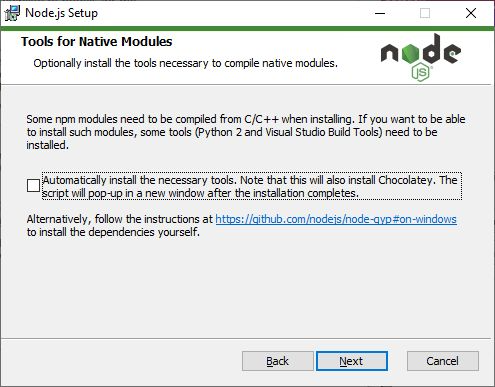
- In the rapidly evolving IT landscape it might occur that the latest versions of Git, Node.js (and npm) differ from the ones we installed when we wrote/updated this course (september 2021)
$ node -v && npm -v
v16.9.1
7.21.1
1
2
3
2
3
2: PHP 7.4.x
- Download PHP 7.4.xx for Windows (VC15 x64 Thread Safe)
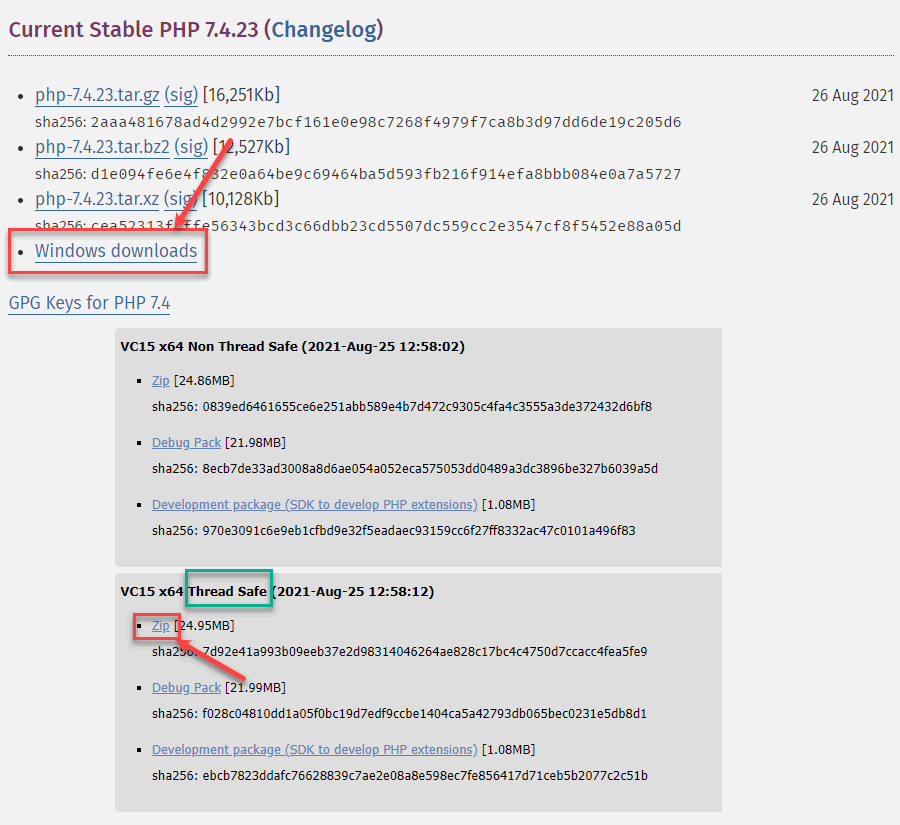
- Extract the zip-file in the root of your C-drive and rename the folder to: C:\PHP74
- Open Omgevingsvariabelen van het systeem bewerken (Edit the system environment variables)
- Click Omgevingsvariabelen... (Environment Variables...)
- Choose under Systeemvariabelen (System variables) the variable Path, and click on Bewerken... (Edit...)
- Click on Nieuw (New) and add C:\PHP74

- Close the Omgevingsvariabelen (Environment Variables) panel entirely!
- Open a new terminal window and check your configuration
$ php -v
PHP 7.4.23 (cli) (built: Aug 25 2021 09:37:03) ( ZTS Visual C++ 2017 x64 )
Copyright (c) The PHP Group
Zend Engine v3.4.0, Copyright (c) Zend Technologies
1
2
3
4
2
3
4
- Duplicate the file C:\PHP74\php.ini-development and rename the file to php.ini
- Open php.ini in an editor and remove the
;(semicolon) in front of the most common extensionsextension_dir = "ext"extension=curlextension=fileinfoextension=gd2extension=mbstringextension=odbcextension=opensslextension=pdo_mysqlextension=sockets
- Increase the memory limit (from 128M) to -1 (unlimited)
memory_limit = -1
- On the desktop, create a new folder phptest containing a new file index.php with the following content
<?php
phpinfo();
1
2
2
- Open a new terminal window inside the phptest folder and start PHP's local test server
$ php -S localhost:8008
1
- Open http://localhost:8008 in a browser
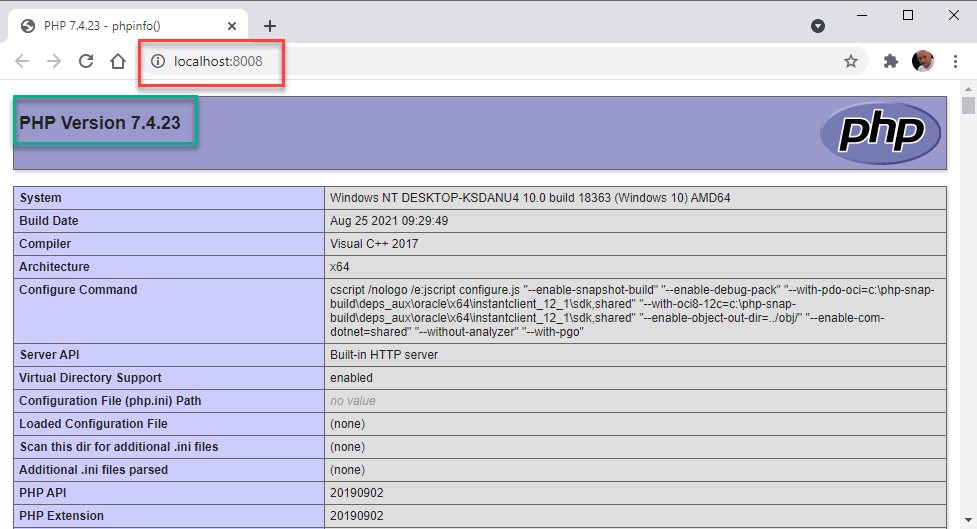
3: Homestead
- Laravel Homestead is an official, pre-packaged Vagrant box that provides you a wonderful development environment
- Homestead lets you run PHP, a web server, and other server software inside VirtualBox
Install VirtualBox & Vagrant
- If necessary, enable Hardware virtualisation in your BIOS (https://www.youtube.com/watch?v=mFJYpT7L5ag)
- Install VirtualBox 6.1.24
WARNINGS
- Be sure to install version 6.1.24 of VirtualBox, because otherwise Homestead will not work!
(At the time of writing, the latest version 6.1.26 contains a bug in conjunction with Vagrant)
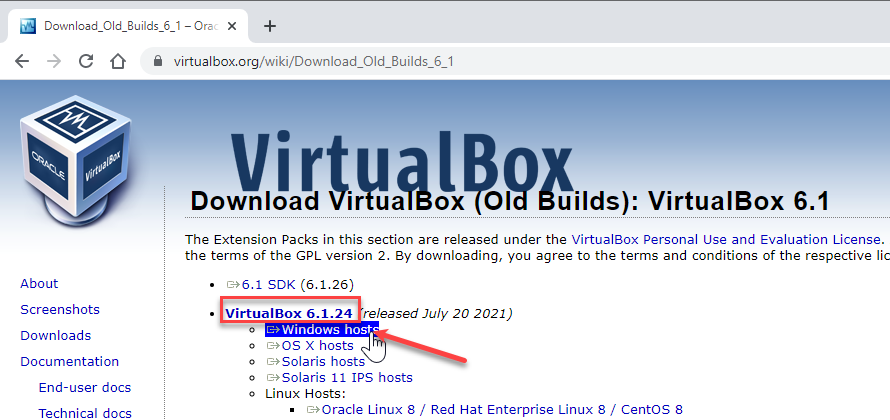
- Disable Check for Updates in VirtualBox's preferences
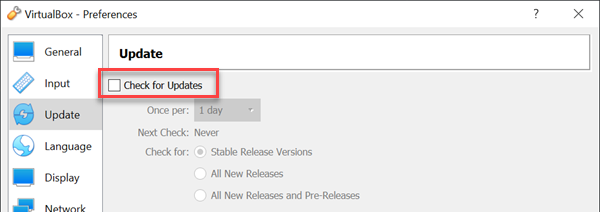
- Open Omgevingsvariabelen van het systeem bewerken (Edit the system environment variables)
- Click Omgevingsvariabelen... (Environment Variables...)
- Click under Systeemvariabelen (System variables) on Nieuw... (New...)
- Naam van de variabele (Variable name): VAGRANT_HOME
- Waarde van de variabel (Variable value): C:\VagrantHome
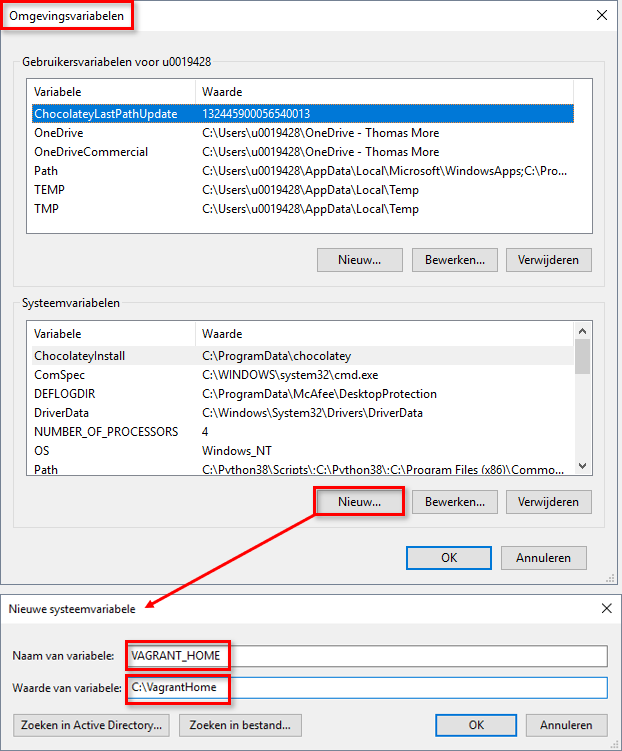
- Install Vagrant and restart your laptop
- Create, at the root of your C-drive, two new folders
- C:\vagrant (where you save the configuration files of the Vagrant box; the box itself will be stored in C:\VagrantHome\boxes)
- C:\sites_laravel (where you store your websites)
Install Homestead
- Open Git Bash in the C:\vagrant folder and execute the following command
$ vagrant box add laravel/homestead --box-version 9.7.2
1
WARNING
Be sure to add version 9.7.2 of the Homestead Vagrant box, because other/newer boxes cause problems in combination with Laravel 7/PHP 7
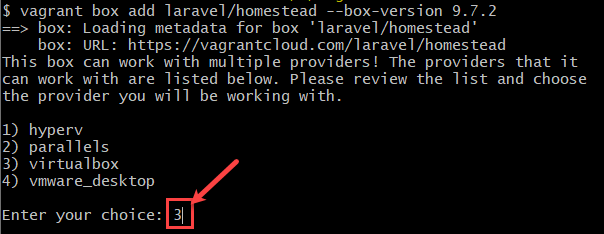
- Choose option 3 (virtualbox) and wait for the box to be downloaded/added
- Next, execute the following commands in the current Git Bash window
$ git clone https://github.com/laravel/homestead.git homestead
$ cd homestead
$ git checkout 18.04
$ bash init.sh
$ vagrant up
1
2
3
4
5
2
3
4
5
WARNING
Again, it is crucial to checkout branch 18.04 to avoid erratic behavior
REMARK
After the command vagrant up, give the necessary permissions to VirtualBox if asked for
- The Vagrant homestead box now appears inside VirtualBox
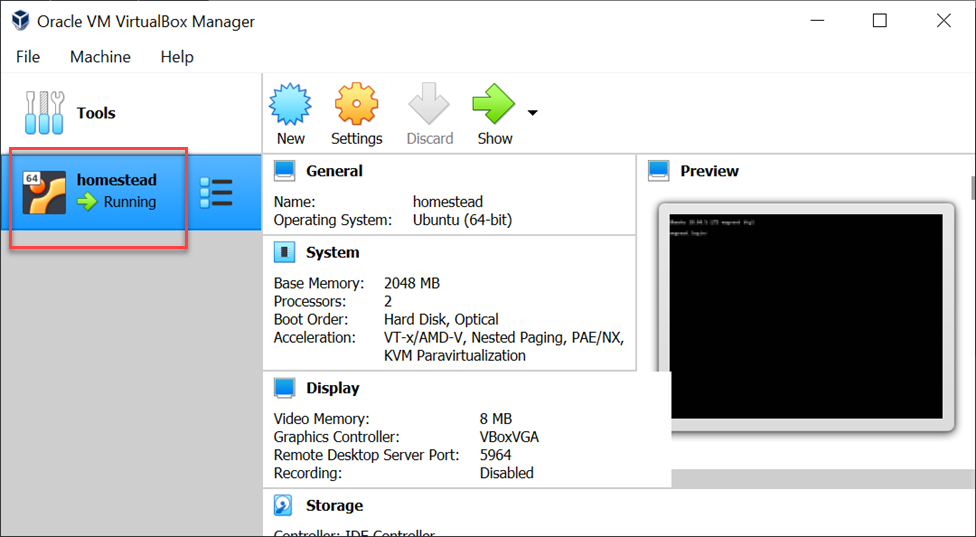
- In the C:\vagrant\homestead folder, open the Homestead.yaml file and adjust the configuration (use a slash instead of a backslash!)
---
ip: "192.168.10.10"
memory: 2048
cpus: 2
provider: virtualbox
backup: true # add this line
authorize: ~/.ssh/id_rsa.pub
keys:
- ~/.ssh/id_rsa
folders:
- map: C:/sites_laravel # change this line
to: /home/vagrant/code
# Don't forget to add all your .test domains to the host file C:\Windows\System32\drivers\etc\hosts
# For example: 192.168.10.10 xxxxxx.test
sites:
- map: homestead.test
to: /home/vagrant/code # change this line (remove /public)
databases:
- homestead
features:
- mysql: true # change from false to true
- mariadb: false
- postgresql: false
- ohmyzsh: false
- webdriver: false
1
2
3
4
5
6
7
8
9
10
11
12
13
14
15
16
17
18
19
20
21
22
23
24
25
26
27
28
29
30
31
2
3
4
5
6
7
8
9
10
11
12
13
14
15
16
17
18
19
20
21
22
23
24
25
26
27
28
29
30
31
REMARKS/EXPLANATION
- Line 6: Homestead automatically backups all your databases (listed under databases: on line 23) when your Vagrant box is destroyed
The backup files can be found in the folder C:\vagrant\homestead\.backup\mysql_backup - Line 14: the base folder for all your Laravel sites
- Line 17-18: just a reminder that you don't forget to add every new test domain to the Windows hosts file 😉
- Line 20: homestead.test is now mapped to C:/sites_laravel
- Line 27: we use mysql for all our databases
- Open (as administrator!) the file C:\Windows\System32\drivers\etc\hosts and add a new domain
192.168.10.10 homestead.test - Create inside the C:\sites_laravel folder a file index.php with the content
<?php echo phpinfo(); - Restart the server
vagrant halt
vagrant up --provision
1
2
2
- Open http://homestead.test in a browser
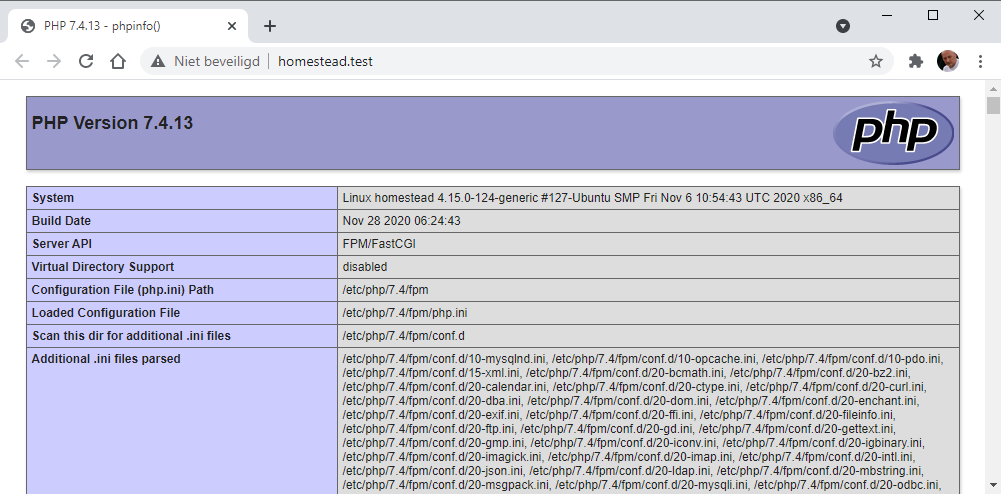
COMMON ERROR MESSAGES AND SOLUTIONS
- Check your Homestead.yaml (or Homestead.json) file, the path to your private key does not exist.
- Go to
%UserProfile%or C:\Users\user_name (in File Explorer) and open Git Bash - Execute the command
mkdir -p .ssh && touch .ssh/id_rsa, which creates the folder C:\Users\user_name.ssh (if it does not exist) and creates an empty private key file in this folder
- Go to
- If the command
vagrant uporvagrant up --provisionhangs (and eventually times out) AND you have a port collision, it is advisable to stop the process causing this conflict- Use the
netstat -a -bcommand or TCPView to check the active processes and their corresponding ports - In the example below, MySQL was running on port 3306. After stopping this service, the homestead server could be started without any problem.
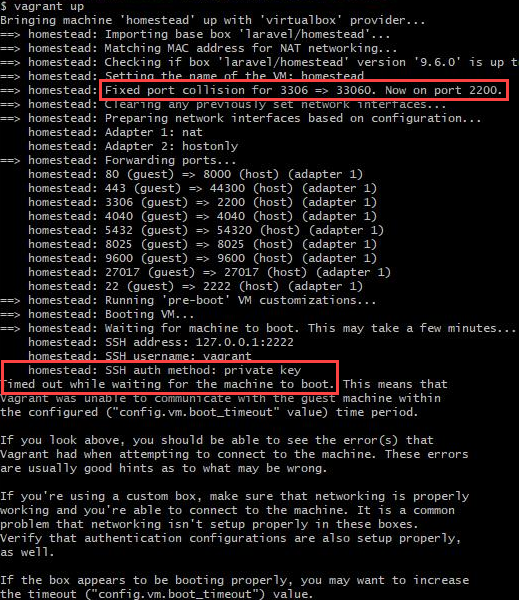
- Use the
Homestead.bat
- From this batch file you can easily perform the most frequently used actions
- Create a new file homestead.bat (on your desktop)
- Open the file and paste the code below
- Double click the file to run the script
@echo off
title Vagrant - Homestead
C:
cd C:\vagrant\homestead
:: uncomment (remove ::) the two lines below if the folder is on a different drive. e.g. D-drive
:: D:
:: cd D:\vagrant\homestead
:home
cls
echo.
echo Select a task:
echo =============
echo.
echo 1) vagrant up (Homestead.yaml hasn't been changed)
echo 2) vagrant up --provision (Homestead.yaml has changed)
echo 3) vagrant halt (shut down Homestead)
echo 4) vagrant port (list of guest ports mapped to the host machine ports)
echo 5) vagrant destroy (destroy Homestead and remove it from VirtualBox)
echo 6) vagrant ssh (type 'exit' or Ctrl+d to exit, default password: vagrant)
echo 0) Exit
echo.
set /p action=Type option:
if "%action%"=="1" goto up
if "%action%"=="2" goto provision
if "%action%"=="3" goto halt
if "%action%"=="4" goto port
if "%action%"=="5" goto confirmDestroy
if "%action%"=="6" goto ssh
if "%action%"=="0" exit
goto home
:up
@echo on
vagrant up
@echo off
pause
goto home
:provision
@echo on
vagrant halt & vagrant up --provision
@echo off
pause
goto home
:halt
@echo on
vagrant halt
@echo off
pause
goto home
:port
@echo on
vagrant port homestead
@echo off
pause
goto home
:confirmDestroy
cls
echo.
echo This action destroys Homestead and remove it from VirtualBox!
echo =============================================================
echo.
echo Before you execute this command, it is best to make a backup
echo of all your databases with phpMyAdmin.
echo - http://homestead.test/phpMyAdmin
echo - http://phpMyAdmin.test
echo.
set /P kill=Are you sure you want to destroy Homestead [Y/N]?
if /I "%kill%"=="Y" ( goto destroy ) else ( goto home)
:destroy
@echo on
vagrant up & vagrant destroy -f
@echo off
pause
goto home
:ssh
@echo on
vagrant ssh
@echo off
pause
goto home
1
2
3
4
5
6
7
8
9
10
11
12
13
14
15
16
17
18
19
20
21
22
23
24
25
26
27
28
29
30
31
32
33
34
35
36
37
38
39
40
41
42
43
44
45
46
47
48
49
50
51
52
53
54
55
56
57
58
59
60
61
62
63
64
65
66
67
68
69
70
71
72
73
74
75
76
77
78
79
80
81
82
83
84
85
86
87
88
89
90
2
3
4
5
6
7
8
9
10
11
12
13
14
15
16
17
18
19
20
21
22
23
24
25
26
27
28
29
30
31
32
33
34
35
36
37
38
39
40
41
42
43
44
45
46
47
48
49
50
51
52
53
54
55
56
57
58
59
60
61
62
63
64
65
66
67
68
69
70
71
72
73
74
75
76
77
78
79
80
81
82
83
84
85
86
87
88
89
90
4: Composer
- Composer is a dependency Manager for PHP
- Download and install Composer: https://getcomposer.org/Composer-Setup.exe
- Open a new terminal window and check your configuration
$ composer -v
______
/ ____/___ ____ ___ ____ ____ ________ _____
/ / / __ \/ __ `__ \/ __ \/ __ \/ ___/ _ \/ ___/
/ /___/ /_/ / / / / / / /_/ / /_/ (__ ) __/ /
\____/\____/_/ /_/ /_/ .___/\____/____/\___/_/
/_/
Composer version 2.1.8 2021-09-15 13:55:14
1
2
3
4
5
6
7
8
2
3
4
5
6
7
8
5: PhpStorm plugin
- Laravel support is provided by means of the Laravel plugin (and the Laravel IDE helper)
- Open PhpStorm (you do not need any PHP/Laravel project at this time) and go to menu File -> Settings -> Plugins, or choose Plugins at the left of the splash welcome screen
- Search for and install the Laravel plugin
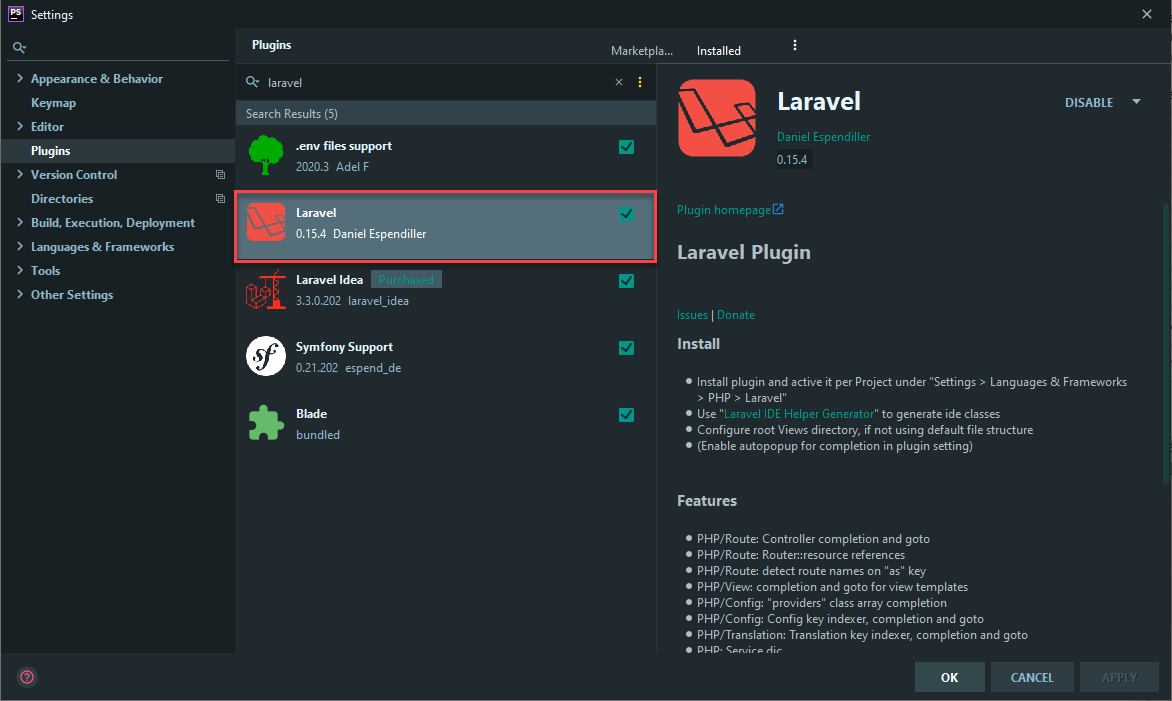
6: PhpMyAdmin
- phpMyAdmin is a free software tool written in PHP, intended to handle the administration of MySQL over the Web
Installation
- Download phpMyAdmin

- Unzip the file at the root of C:\sites_laravel and rename the folder to phpMyAdmin (C:\sites_laravel\phpMyAdmin)
- phpMyAdmin is now available at http://homestead.test/phpMyAdmin/
- Login with name homestead and password secret
Set hostname
- Open C:\vagrant\homestead\Homestead.yaml and add, under sites, a new path to phpMyAdmin
sites:
- map: homestead.test
to: /home/vagrant/code
- map: phpmyadmin.test
to: /home/vagrant/code/phpMyAdmin
1
2
3
4
5
2
3
4
5
- Open the file C:\Windows\System32\drivers\etc\hosts (as administrator!) and add a new domain
192.168.10.10 phpmyadmin.test - Next, execute the following commands in the current Git Bash window (or run option 2 from homestead.bat)
$ vagrant halt
$ vagrant up --provision
1
2
2
- phpMyAdmin is also available at http://phpmyadmin.test
Auto login
- If you want, you can make sure that you are automatically logged in
- Open the folder C:\sites_laravel\phpMyAdmin
- Rename (or duplicate and rename) config.sample.inc.php to config.inc.php
- Open config.inc.php
- Find the variable
$cfg['Servers'][$i]['auth_type']and change the variable value from'cookie'to'config' - Add three extra lines of code
$cfg['Servers'][$i]['auth_type'] = 'config'; // Change from 'cookie' to 'config'
$cfg['Servers'][$i]['user'] = 'homestead';
$cfg['Servers'][$i]['password'] = 'secret';
$cfg['CheckConfigurationPermissions'] = false;
1
2
3
4
5
2
3
4
5